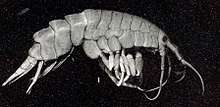Calliopius
Calliopius is a genus of amphipods in the family Calliopiidae. There are about nine described species in Calliopius.[1][2][3]
| Calliopius | |
|---|---|
 | |
| Calliopius laeviusculus | |
| Scientific classification | |
| Kingdom: | Animalia |
| Phylum: | Arthropoda |
| Subphylum: | Crustacea |
| Class: | Malacostraca |
| Superorder: | Peracarida |
| Order: | Amphipoda |
| Family: | Calliopiidae |
| Genus: | Calliopius Liljeborg, 1865 |
Species
These nine species belong to the genus Calliopius:
- Calliopius behringi Gurjanova, 1951
- Calliopius carinatus Bousfield & Hendrycks, 1997
- Calliopius columbianus Bousfield & Hendrycks, 1997
- Calliopius crenulatus Chevreux & Fage, 1925
- Calliopius georgianus Pfeffer
- Calliopius laeviusculus (Krøyer, 1838)
- Calliopius pacificus Bousfield & Hendrycks, 1997
- Calliopius rathkii Zaddach, 1844
- Calliopius sablensis Bousfield & Hendrycks, 1997
gollark: Specifically datacentre ones, I think the Xeon Platinum 8280 and such.
gollark: High-end Intel CPUs.
gollark: There are some very cool designs for those around.
gollark: Excepting conlangs nobody speaks.
gollark: That's most of them.
References
- "Calliopius Report". Integrated Taxonomic Information System. Retrieved 2019-09-23.
- "Calliopius". GBIF. Retrieved 2019-09-23.
- "Calliopius genus Information". BugGuide.net. Retrieved 2019-09-23.
Further reading
- Bousfield, E. L.; Hendrycks, E. A. (1997). "The Amphipod Superfamily Eusiroidea in the North American Pacific Region. II. Family Calliopiidae. Systematics and Distributional Ecology". Amphipacifica. 2 (3): 3–66. ISSN 1189-9905.
This article is issued from Wikipedia. The text is licensed under Creative Commons - Attribution - Sharealike. Additional terms may apply for the media files.